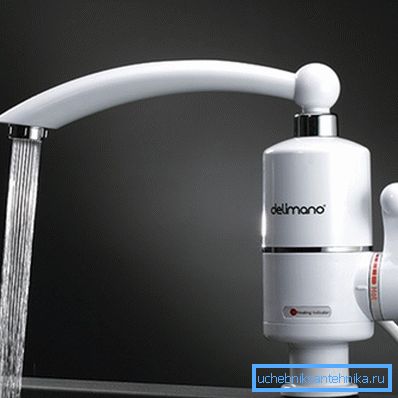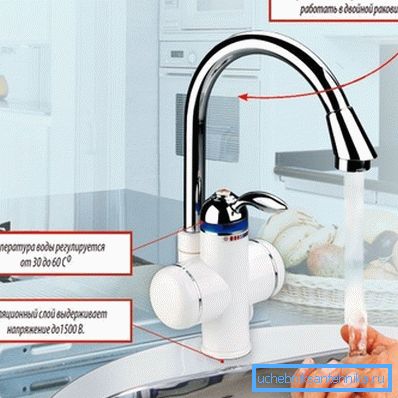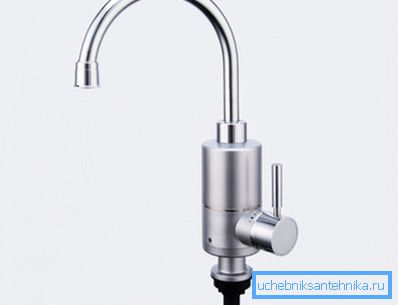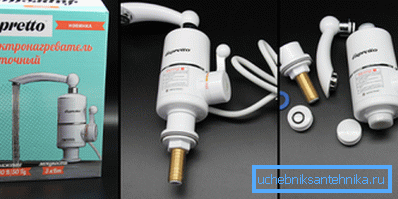Tap with electric water heater: we provide hot water with
The flowing household electric heater - many consider the crane as a kind of alternative to boilers or gas wall boilers. A rational grain is undoubtedly present in such reasoning, but it is not worth relying only on this device.
In our article we will describe the design of heating cocks, as well as consider the main pros and cons of such systems.

Product design
The crane - the electric heater, in fact, is an ordinary mixer, inside of which a sufficiently powerful (naturally, adjusted for size) heating element is placed.
Completion of the device depends on the specific model, but most often the system includes the following details:
- Body - steel, polymer or made of special alloys.
Note! Cheap Chinese models are made of fairly fragile plastic, therefore it is better to refuse to purchase them: not only is the material cracked under mechanical loads, it is also deformed during prolonged contact with hot water.

- TEN - the main node that provides rapid heating of water to 60 ° C. Most often flowing heaters for household use are completed with heating elements from 2.5 to 4 kW.
- The control group - devices that ensure the safe operation of the entire system. Usually, the control group includes a thermostat and a thermocouple that turns off the heating element when it reaches the desired degree of heating, as well as during closures and other unforeseen situations.
- Water pressure sensor. Regulates the operation of the heating element, not allowing the inclusion in the dry mode.
- Coarse Filter. In some models, installed at the entrance to the system, detains large particles of garbage, limescale deposits from pipes, rust flakes, etc. The use of a coarse filter significantly extends the effective operation of the crane.
Adjustment of the system is carried out using a three-position handle. By rotating it, we can either shut off the flow completely, or turn on hot or cold water. When the handle is installed in the “hot” position on the body, the indicator light usually lights up, signaling the activation of the heating element.

Specifications that should be advised enough high-quality nozzle on the faucet - flowing electric heater, are as follows:
| Parameter | Value |
| System operating pressure | not less than 0.4 atm / 0.04 MPa |
| System pressure | no more than 7 atm / 0.7 MPa |
| Power supply voltage | 220 V |
| Current frequency | 50 Hz |
| Power consumption | 2.5 to 4 kW |
| Working temperature | Up to 600С |
| Security | IPx4 and above |
| Pipeline connection | ? an inch |
The expediency of installation
Advantages of flow heaters
To date, neither specialists in the field of water supply, nor consumers have a unanimous opinion in relation to such devices. Some people consider them insufficiently reliable, others consider the heating device quite suitable for private use.
So that you can make a sensible choice on your own, we suggest analyzing all the pros and cons.
So, the advantages possessed by such cranes with heating include the following:
- First, the water in the tap heats up almost instantly. Of course, there will be a slight delay between turning the knob and the flow of fluid (about 5 seconds for high-quality models), but then the flow is quite stable and at an acceptable pressure.

- Secondly, the system is compact. Externally, these faucets look the same as regular faucets for sinks, and their design is quite decent: in any case, such a structure will not look like an alien object in the kitchen.
- Thirdly, having once set up the system, it is not necessary to select the optimum water temperature each time. If you use a water tap for dishwashing or washing, it is very convenient.
- The price is also an advantage of such products. Of course, they are inferior in functionality to storage water heaters, but if you choose to buy such a faucet or boiler for 50 liters (the minimum available volume from most manufacturers), then the result of the comparison will be obvious.

Main disadvantages
However, not everything is so rosy, because the system has its drawbacks.
And most often they are a continuation of the above advantages:
- For the instantaneous heating of the water you have to pay an excessive consumption of electricity and the rapid deterioration of the heating element. If you use a crane in the usual mode, with frequent on and off, then its resource is reduced very much.
- With increasing pressure increases the speed of movement of water on the heating element, and therefore, its temperature decreases. So, it is only theoretically possible to get a bath, as the advertising promises us: it will take this process quite a lot of time, and the accumulated water will have time to cool down.
- The reliability of the design is also in doubt. In principle, there are qualitative models on the market, but they belong to a rather expensive segment. And for budget devices, neither the frequent burnout of heating elements, nor the failure of thermocouples are anything out of the ordinary.
In addition, it should be noted that these taps are exclusively household devices. Other systems are used to heat water or maintain the temperature of the coolant on an industrial scale, which, however, work according to similar principles.
An example of such a design is a polyethylene crane saddle with electric heaters, which is mounted on gas pipe leads.
As a result, it can be summarized: if hot water is supplied to your home intermittently, then it is quite possible to install such a faucet on the kitchen sink. But here it is better to use it as a backup system, rarely and little by little. As a full-fledged alternative to the boiler, alas, it will not work.
Mounting technique
Another obvious advantage of taps with integrated water heaters is the ease of installation with your own hands. If for installation of a boiler it is necessary to involve a certified crew, then the task here will be no more difficult to fix the conventional device of the sink mixer.

The instruction assumes performance of work in the following sequence:
- Shut off the water on the standpipe of water supply, then unscrew the cap nuts of the hoses attached to the old mixer.
- Dismantle the old mixer.
- In its place we install a new water heater.
- To the conclusions of the hot and cold water we reconnect the pipes, carefully fastening them with cap nuts.
- The power cable is either plugged in, or through a cable channel to the distribution box. In this case, it is best to connect the product through a safety device.

Note! Quality models are usually equipped with built-in RCDs, which significantly increases the level of safety of use.
- Turn on the water on the riser and check the tightness of all connections.
- Following the manufacturer's recommendations, we perform the adjustment of the work of the heating element, setting the optimum temperature.
Conclusion
By installing a running electric heater on the faucet, we can at least partially solve the problem of hot water supply. And at least you should not dream of taking a bath, but it is quite possible to wash and wash the dishes with comfort. So that you can study the devices described above in more detail, we recommend watching the video in this article.